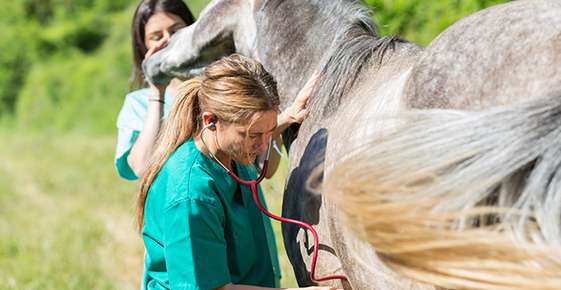Physical Exam
Your horse might look as healthy as, well, a horse, making you wonder whether he really needs an annual exam. However, if anything is wrong with your horse’s health, it’s always better to detect a problem earlier rather than later. Your equine veterinarian can also advise on preventive measures to take to preserve your horse’s good health.
Each equine veterinarian has his or her way of conducting a physical exam. Here’s more or less what to expect.
History Review
Before you go to the veterinarian, jot down any of your concerns. If you’ve noticed changes in your horse’s physical condition, behavior or lifestyle — such as living with new animals or traveling more or less — be sure to mention them to the vet.
Checking the Heart
When your veterinarian listens to your horse’s heart, he or she is listening for heart rate, rhythm and the sounds the heart itself makes. The average healthy horse’s resting heart rate is between 32 and 44 beats per minute; though this can vary. Deviations from that rate — or irregular rhythm or strange sounds, such as murmurs — could indicate a dangerous heart condition.
Checking the Lungs
Your vet will listen to your horse’s lungs through a stethoscope. Breathing should be soft and quiet. Wheezes, crackles and other abnormal sounds can clue your vet in to inflammation or excess mucus in the lungs or trachea.
Stomach Sounds
When the stethoscope moves to your horse’s gastrointestinal (GI) tract, your vet hopes to hear the normal grumbling sounds that indicate good digestion. If the gut is too quiet, gassy or liquid-sounding, there could be problems.
Temperature
Your vet will use a rectal thermometer to measure your horse’s temperature. The normal range is 99.5 to 100.5 degrees Fahrenheit. A fever, which can suggest infection or inflammation, is 102 degrees Fahrenheit or higher.
Weight and Body Condition
Given that few scales will accommodate a horse, your veterinarian will resort to other methods of estimating your horse’s weight. One calculation method involves measuring your horse’s girth at the chest and its length from shoulder to hip. The vet will give your horse a body conditioning score from one to nine to assess fitness or fatness. One is emaciated. Nine is obese. Your vet will use the amount of fat over the horse’s spine, ribs, hip and neck to determine this score.
Looking in the Mouth
Horses won’t tolerate a thorough oral exam without sedation. However, your vet will try to get a peek inside your horse’s mouth. He or she will be looking for jagged, sharp and irregular places on the molars and front teeth. These spots will need to be floated, or filed down.
Eye Exam
The eye exam involves shining a bright light into your horse’s eyes to assess clarity of the lens and cornea and to test the pupils for normal contraction. For a more thorough exam, your vet will use an ophthalmoscope to check out the retina.
Palpations
Your vet will want to manually palpate the horse’s entire body, checking the lymph nodes, inspecting its skin for parasites or inflammation and feeling all the muscles, joints and tendons for stiffness or pain. Hooves will be checked for cracks, white line disease and other problems.
Vaccinations
Depending on where you live and how much your horse travels, your vet might recommend different vaccinations. Common diseases to get your horse vaccinated against include Western Equine Encephalitis, Eastern Equine Encephalitis, tetanus and West Nile.
Deworming
Worms are a fact of life for horses, so regular deworming is crucial. Your vet will prescribe deworming medications or review its current deworming regimen.
It sounds like a lot, but the whole exam will only take about 10 minutes. Your equine veterinarian may have recommendations based on his or her findings, your horse’s activity level, your horse’s age and other factors.
Regular physical exams are vital to maximize your horse’s health and longevity. Call our office today, and we can schedule a thorough exam.

